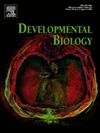着床前胚胎发育过程中与YAP动力学相关的几何、细胞周期和母体到合子的过渡。
IF 2.5
3区 生物学
Q2 DEVELOPMENTAL BIOLOGY
引用次数: 0
摘要
在哺乳动物胚胎的第一次细胞命运决定过程中,从滋养外胚层细胞(胎盘的前体)中分离出来的内细胞群细胞将产生胚胎本身和其他胚胎外组织。细胞命运分离是一个渐进的过程,包括两轮细胞分裂,以及细胞位置和形态的变化。虽然已知Hippo信号通路的活性及其下游效应物YAP的亚细胞定位决定了谱系特异性基因的表达,但YAP对这些动态细胞变化的反应仍不完全清楚。在这里,我们通过内源性标记的YAP的定量实时成像来解决这些问题,同时在细胞命运分离过程中监测几何细胞特征和细胞周期进程。我们将概率模型应用于我们的动态数据,提供了YAP和细胞相对暴露面积相互作用的定量表征,这已经被证明与固定样本中的亚细胞YAP定位相关。此外,我们还研究了细胞核YAP水平如何受到其他因素的影响,如母体提供的通过卵裂分裂分配给子细胞的YAP数量减少,细胞周期相关的核体积变化,以及分裂后将YAP水平调整到新的细胞位置的延迟。有趣的是,我们发现建立内细胞质量命运所需的低核YAP水平主要是通过被动细胞周期相关机制实现的。此外,与预期相反,我们发现导致细胞和细胞核形状变化的机械扰动不会影响胚胎中YAP的定位。我们的工作共同确定了各种输入如何在动态发育时间过程中整合,以塑造第一个细胞命运选择的关键分子决定因素的水平。本文章由计算机程序翻译,如有差异,请以英文原文为准。
Geometric, cell cycle and maternal-to-zygotic transition-associated YAP dynamics during preimplantation embryo development
During the first cell fate decision in mammalian embryos, the inner cell mass cells, which will give rise to the embryo proper and other extraembryonic tissues, segregate from the trophectoderm cells, the precursors of the placenta. Cell fate segregation proceeds in a gradual manner encompassing two rounds of cell division, as well as cell positional and morphological changes. While it is known that the activity of the Hippo signaling pathway and the subcellular localization of its downstream effector YAP dictate lineage specific gene expression, the response of YAP to these dynamic cellular changes remains incompletely understood. Here we address these questions by quantitative live imaging of endogenously tagged YAP while simultaneously monitoring geometric cellular features and cell cycle progression throughout cell fate segregation. We apply a probabilistic model to our dynamic data, providing a quantitative characterization of the mutual effects of YAP and cellular relative exposed area, which has previously been shown to correlate with subcellular YAP localization in fixed samples. Additionally, we study how nuclear YAP levels are influenced by other factors, such as the decreasing pool of maternally provided YAP that is partitioned to daughter cells through cleavage divisions, cell cycle-associated nuclear volume changes, and a delay after divisions in adjusting YAP levels to new cell positions. Interestingly, we find that establishing low nuclear YAP levels required for the inner cell mass fate is largely achieved by passive cell cycle-associated mechanisms. Moreover, contrary to expectations, we find that mechanical perturbations that result in cell and nuclear shape changes do not influence YAP localization in the embryo. Together our work identifies how various inputs are integrated over a dynamic developmental time course to shape the levels of a key molecular determinant of the first cell fate choice.
求助全文
通过发布文献求助,成功后即可免费获取论文全文。
去求助
来源期刊

Developmental biology
生物-发育生物学
CiteScore
5.30
自引率
3.70%
发文量
182
审稿时长
1.5 months
期刊介绍:
Developmental Biology (DB) publishes original research on mechanisms of development, differentiation, and growth in animals and plants at the molecular, cellular, genetic and evolutionary levels. Areas of particular emphasis include transcriptional control mechanisms, embryonic patterning, cell-cell interactions, growth factors and signal transduction, and regulatory hierarchies in developing plants and animals.
 求助内容:
求助内容: 应助结果提醒方式:
应助结果提醒方式:


